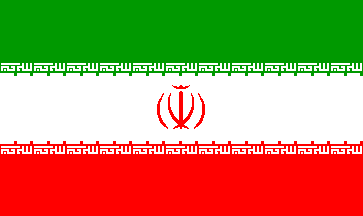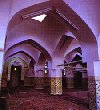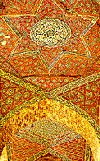 Zanjan
is the capital of the Iranian province of the same name. Zanjan has a predominantly
Azeri population. In Iran the Azeris are also the main ethnic group in
Western Azerbaijan province, with its capital in Uromiyeh,
Eastern Azerbaijan province, with its capital in Tabriz
and Ardebil, whose capital is also called Ardebil.
There are important Azeri communities in and around Hamadan, in Tehran,
around Qom and Saveh, Khorasan province, and are scattered throughout many
other parts of Iran.
Zanjan
is the capital of the Iranian province of the same name. Zanjan has a predominantly
Azeri population. In Iran the Azeris are also the main ethnic group in
Western Azerbaijan province, with its capital in Uromiyeh,
Eastern Azerbaijan province, with its capital in Tabriz
and Ardebil, whose capital is also called Ardebil.
There are important Azeri communities in and around Hamadan, in Tehran,
around Qom and Saveh, Khorasan province, and are scattered throughout many
other parts of Iran.
 The
city of Zanjan is located 320 km northwest of Tehran, it lies on an open
valley about halfway along the main road and railway to Tabriz. There are
good bus connections to Tehran as well as regular flights. With a present
day population of 300.000, the construction of the city is attributed to
Ardeshir Babakan. Zanjan is administratively divided into three parts:
the central part (the city itself), and two districts outside the city
called Mahanshan and Tarom-e-olya.
The
city of Zanjan is located 320 km northwest of Tehran, it lies on an open
valley about halfway along the main road and railway to Tabriz. There are
good bus connections to Tehran as well as regular flights. With a present
day population of 300.000, the construction of the city is attributed to
Ardeshir Babakan. Zanjan is administratively divided into three parts:
the central part (the city itself), and two districts outside the city
called Mahanshan and Tarom-e-olya.
Zanjan probably dates back to the Sassanid
period. Conquered by the Muslims in the 7th century, obliterated by the
Mongols and by Tamerlane in the 13 th and 14 th centuries, and having a
vivid record in civilization, culture, arts and sciences, Zanjan has experienced
both glory and hardship. The city is know for the Zanjan upheaval, resulting
in what was by far the largest of the battles between the members of the
Bahai movement and Persian troops during the late 1840s and early 1850s,
involving perhaps three thousand Bahais and thirty thousand government
troops and irregulars. Prior to the Iranian Revolution, the city witnessed
fighting between the local people and the Iranian army in 1978.
The city is the centre of an agricultural
zone with abundant grain harvests. Industries produce milled rice and flour,
hand-woven cloth, metal ware, and coarse carpets.
 Zanjan
is well worth exploring, its most interesting historical buildings are:
Zanjan
is well worth exploring, its most interesting historical buildings are:
-
The Bazaar - This late 18th century building
(Qajar period) is the place to truly feel Zanjan's pulse. Divided into
the upper and lower bazaar, its statistics will make jealous many modern
shopping centre managers: 150.000 square metres, 940 shops, 56 entrances,
two baths (Bollori and Moini) and even a Mosque.
-
The Caravanserai Sangi - the ancient inn for
caravans travelling from Asia to Europe, built in the 16th century, during
the Safavid dynasty, is the oldest building in Zanzan city. During recent
times it has fallen into disrepair, and it's current appearance doesn't
make justice to its former glories.
-
The Friday (Jame) Mosque - The Mosque and
adjoining Islamic school date from the Qajar period. The building has delicate
and intricate decoration in tilework, providing an exceptional visual effect,
and the architecture with tall arches and ample verandas make it most elegant.
-
The Mirzayee Mosque - This is the oldest religious
building in the city, dating to the end of the Safavid era (early 18th
century), it its strategically located inside the lower bazaar,
-
The washing house (Rakhat Shooy Khane) - Located
in the old part of the city (Sadi st.) this beautifully designed public
building was traditionally used by Zanjan's inhabitants to wash their clothes
and linen.
-
the Zolfaghari building - This 18th century
building shows a unique combination of Gothic and Persian architecture,
with gabled roofs and stained glass. It's located in the centre of the
old town.
The Zanjan province has an area of
25382 square Kilometers. Besides Azeri, Farsi Kurdish and Tati are the
main languages spoken. Being generally mountainous and hilly, it is divided
into three regions with different climates. Takht-e-soleyman, Taleghan,
Alamout, and Kooh-e-Rostam are the most important mountains in the province.
South of village of Garmab, 140 km south-west of Zanjan city, lies the
cave of Katlekhor. The rivers Ghezel Ozan, Abhar Rood and shah Rood flowing
from the mountains through the province, supporting abundant vegetation.
Among the natural resources of this province, there are six hot springs
and four mineral springs in with medicinal value, attracting large numbers
of visitors.
The vegetation of the province varies from
one area to another, but it is generally made up of forests and pastures.
The forests are mainly located in the mountainous regions adjacent to Gilan
province. Different climates have created an animal life rich in variety.
Various species of wild animals, native and migratory birds , and aquatic
animals attract many tourists in the seasons during which hunting is allowed.
Due to numerous rivers and underground
streams, as well as many pastures, agriculture and animal-husbandery enjoy
considerable prosperity. There are many mines in Zanjan province, providing
raw materials for many home factories. kaolin, silver, gold, copper, iron,
manganese, feldspat and silica mines are some of the mines, among others,
in the province. Zanjan province is one of the country's important
industrial centres, throughout which there are several industrial satellite
towns and metal, food, chemical, wood, weaving, construction and mining
industries. Of the local industries of the province, particularly of Zanjan
city, cutlery has a reputation for products of which are unique in delicacy
and solidity. The area is famous for its carpets, filigree work and "Charoghs"
(sandals).
Other places of interest in the Zanjan
province:
Abhar
Located in the south-east of Zanjan, in
a mountainous region, this city has a mild climate. The river Abhar flows
through the city. The river, on the banks of which there are the relics
of an ancient citadel named Ghaleh Tappeh, served as a natural barrier
against the enemies. Two of the tourist attractions of the city are the
complex of Soltanieh and Imamzadeh Esma'il.
 The
Complex of Soltanieh
The
Complex of Soltanieh
Located 32 km southeast of Zanjan,
this complex built in the 15 th century is a world-famous monument and
the greatest attraction of Zanjan province. Once the capital of Ilkhan
dynasty, Soltanieh district in which the complex is situated, is at a distance
of 43 km from the Tehran - Zanjan highway. Having archaeological remains
dating back to circa 3000 years ago, Soltanieh district had been the home
of various peoples before the invasion of Iran by the Mongols. The most
significant part of the said complex is the Gonbad (dome) -e-Soltanieh.
It is the biggest dome in Iran and one of the most splendid buildings throughout
the Islamic world.
Takestan
This city is located in the south-east
of Zanjan province and has cold and long winters and mild summers. Its
important rivers are Rood-e-shoor and Abhar Rood on which the town's agriculture
is dependent. The name of the city means "Vineyard", indicating the great
number of the fields of grape - vines and the significant role of
agriculture in the city's economy. Bogh'e-ye-pir and the baths dating
back to the Safavid period, are the histourical monuments of the town.
The highway of Tehran to Europe and the Tehran - Tabriz railway, passing
the through the city, have brought it noticeable development.
Khoda Bandeh
 This
town is located 85km south of Zanjan. Being in a mountainous region, it
has cold and dry winters and mild summers. The town's economy is bassed
on agriculture and animal husbandry. The shrine of Ghidar-e-Nabi is one
of its sights.
This
town is located 85km south of Zanjan. Being in a mountainous region, it
has cold and dry winters and mild summers. The town's economy is bassed
on agriculture and animal husbandry. The shrine of Ghidar-e-Nabi is one
of its sights.
Qazvin
Town 130 Northwest of Tehran on the Tehran-Tabriz
railway line. Built at an altitude of 1800 metres is worth visiting for
the Chehel Sotune building (now a museum), the Shahzadeh Hussein mausoleum,
and naturally the vast bazaar.
sources: netiran, Sharif Cultural Institute
| A to Z of Azerbaijan
/ A dan Z ye Azerbaycan |
www.azerb.com
|
 The
city of Zanjan is located 320 km northwest of Tehran, it lies on an open
valley about halfway along the main road and railway to Tabriz. There are
good bus connections to Tehran as well as regular flights. With a present
day population of 300.000, the construction of the city is attributed to
Ardeshir Babakan. Zanjan is administratively divided into three parts:
the central part (the city itself), and two districts outside the city
called Mahanshan and Tarom-e-olya.
The
city of Zanjan is located 320 km northwest of Tehran, it lies on an open
valley about halfway along the main road and railway to Tabriz. There are
good bus connections to Tehran as well as regular flights. With a present
day population of 300.000, the construction of the city is attributed to
Ardeshir Babakan. Zanjan is administratively divided into three parts:
the central part (the city itself), and two districts outside the city
called Mahanshan and Tarom-e-olya.
 Zanjan
is the capital of the Iranian province of the same name. Zanjan has a predominantly
Azeri population. In Iran the Azeris are also the main ethnic group in
Western Azerbaijan province, with its capital in Uromiyeh,
Eastern Azerbaijan province, with its capital in Tabriz
and Ardebil, whose capital is also called Ardebil.
There are important Azeri communities in and around Hamadan, in Tehran,
around Qom and Saveh, Khorasan province, and are scattered throughout many
other parts of Iran.
Zanjan
is the capital of the Iranian province of the same name. Zanjan has a predominantly
Azeri population. In Iran the Azeris are also the main ethnic group in
Western Azerbaijan province, with its capital in Uromiyeh,
Eastern Azerbaijan province, with its capital in Tabriz
and Ardebil, whose capital is also called Ardebil.
There are important Azeri communities in and around Hamadan, in Tehran,
around Qom and Saveh, Khorasan province, and are scattered throughout many
other parts of Iran.
 Zanjan
is well worth exploring, its most interesting historical buildings are:
Zanjan
is well worth exploring, its most interesting historical buildings are:
 The
Complex of Soltanieh
The
Complex of Soltanieh
